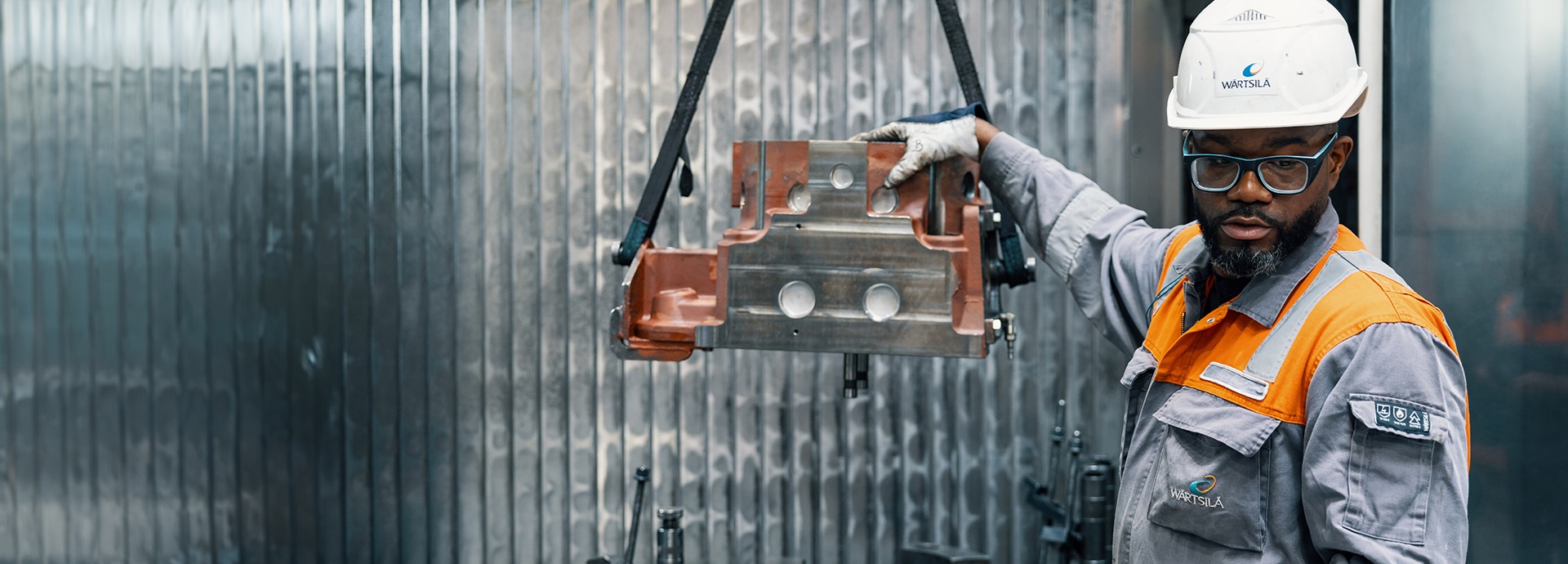

Ship owners and operators are under more pressure than ever to find new ways to improve energy efficiency and replace fossil fuels with low-carbon or zero-carbon alternatives. It might surprise you to learn that smart ship owners and operators can have a big impact on vessel emissions via their spare parts.
Here are five things that can make your spare parts more sustainable.
- Using spare parts that have a long lifetime
- Making sure emission-critical parts are low-emission and compliant
- Measuring the real lifecycle impact of the spare parts you use
- Using parts that are packaged in packaging that can be disposed of responsibly or recycled
- Choosing a supplier that has optimised their logistics chain to be as sustainable as possible
1. Using spare parts that have a long lifetime
When you want your spare parts to be as sustainable as possible, you need to consider them over their lifetime. A high-quality spare part from an original equipment manufacturer (OEM) can have a considerably longer lifetime than a non-OEM part. In this way, using OEM parts will help to extend the lifetime of your asset.
OEM parts are thoroughly checked and tested to comply with major quality standards and relevant regulations. They are also made of high-quality materials according to the correct design specifications and tolerances to ensure proper fit and predictable performance. OEMs follow strict quality management procedures and the parts they manufacture are typically delivered with a full warranty.
High-quality spare parts can also be refurbished, giving them an even longer lifetime. OEMs such as Wärtsilä help you achieve smoother ship overhauls with reconditioned, remanufactured or re-calibrated parts. For example, you can buy reconditioned parts that are ready to use immediately through the Wärtsilä Exchange Parts service. You simply buy the parts you need, install them and then return your old parts to Wärtsilä. This avoids the need to wait for your old parts to be reconditioned before you can proceed with the overhaul. Reusing parts also helps save natural resources and reduces the waste associated with ship overhauls.
Handpicked related content:
To learn why genuine spare parts are the best choice, download this white paper:
Why genuine spare parts are the best choice for your vessel – 5+1 great reasons.
2. Making sure emission-critical parts are low-emission and compliant
Spare parts can have a big impact on your ship’s emissions – and non-OEM parts can cause a compliance headache.
This is another reason why choosing genuine OEM parts is a good idea. Genuine spare parts will help you to eliminate the risk of non-compliance. But how do you know if your emission-critical spares are genuine and therefore compliant?
The best way to be sure your parts are compliant is to only use the NOx-critical components that are listed in the technical file for your ship’s engine. You can identify emission-critical components using the unique International Maritime Organization (IMO) ID number marked in the NOx technical file and stamped on the spare part itself. Some OEMs, including Wärtsilä, also stamp their company logo on new emission-critical spare parts.
You can easily check if a spare part is compliant by comparing the ID number in the NOx technical file with the number stamped on the part. If the numbers don’t match, then the part is not emission compliant.
Handpicked related content:
Looking for more tips that help keep your operations compliant? Read this article:
Ship spares: Five top tips to help keep your operations compliant.
3. Measuring the real lifecycle impact of the spare parts you use
The processes used to manufacture spare parts for marine applications generate emissions and use natural resources. However, many OEMs including Wärtsilä are shifting towards more sustainable manufacturing practices.
For example, Wärtsilä is in the early stages of assessing the carbon footprint of spare parts with the help of ReFlow, the lifecycle-based environmental quantification system. Thanks to ReFlow, manufacturers can calculate the carbon footprint of their products throughout the entire supply chain, from raw material extraction to disposal. This helps manufacturers to better understand and manage the environmental impact associated with all stages of a product's life and make more informed and environmentally conscious decisions.
But how can you know which spare parts are environmentally responsible, or how big a product’s carbon footprint is? Look for evidence to back up ‘green’ claims. Third-party certifications are often the best way to understand how environmentally friendly a product really is. For example, any product that has gone through a ReFlow lifecycle assessment comes with a climate assessment report. The report shows the real lifecycle impact of the product on the environment, making it easier for you to compare different offerings.
ReFlow assessments also align with ISO 14040 and 14044 standards, which provide a structured and standardised framework for conducting a product Life Cycle Assessment (LCA). In other words, if you can find spare parts that have earned one or several third-party certifications, then you can trust that what you’re buying meets the standards. It is worth remembering, however, that lifecycle assessments should be viewed as a tool for ongoing improvement in environmental performance rather than a one-off process.
4. Using parts that are packaged in packaging that can be disposed of responsibly or recycled
If you want your spare parts to be as sustainable as possible, you must also consider the packaging that the parts come wrapped in.
Many spare parts are still packaged in plastic because it prevents corrosion and protects the parts from the outside environment, greatly increasing their shelf life. But most conventional plastics are non-biodegradable, which means they take hundreds if not thousands of years to break down. When they do eventually degrade, they release harmful chemicals into the environment. This is why many manufacturers are looking into more eco-friendly packaging materials like compostable paperboard.
Wärtsilä, for example, has been running pilots in collaboration with some of its customers to test alternative packaging materials. In these pilot projects Wärtsilä and its suppliers have replaced many plastics with paper-based packaging. In 2024 alone, Wärtsilä reduced the amount of plastic in its packaging by almost 70%, equal to approximately 35,000 kg.
But paper-based packaging isn’t suitable for some parts. For example, parts made from metal are typically packed in volatile corrosion inhibitor (VCI) plastic because it protects the parts from rusting and corrosion caused by humid environments.
Wärtsilä is exploring options to tackle this challenge. These options include testing paper-based VCI packaging and thinner plastic-based VCI packaging, which can reduce the total amount of plastic used in packaging by 75%. With any new packaging concept, it is important that the materials do not negatively impact the quality or lifetime of the components.
Handpicked related content:
Learn more about how Wärtsilä is collaborating with one of the world’s largest cruise operators to reduce plastic packaging. See page 49 of Carnival Corporation’s sustainability report from 2023.
5. Choosing a supplier that has optimised their logistics chain to be as sustainable as possible
In recent years, many parts manufacturers have been using more sustainable ways to ship their products while still meeting customer expectations. This is important because transportation accounts for nearly a quarter of global CO2 emissions.
Wärtsilä, for example, has centralised its logistics operations into a few strategically important locations to make the transportation routes as short as possible for customers. A pilot project in the Netherlands to optimise transport routes has demonstrated that picking up parts weekly instead of three or four times per week can reduce:
- CO2 emissions by 80%
- freight costs by 50%.
Wärtsilä is planning to continue optimising parts transportation and will extend the pilot to include more locations. But all this has to be done without jeopardising customer service and satisfaction. For example, in cases where spare parts are needed urgently, the most eco-friendly mode of transport may not always be the quickest. In these cases, getting the part to the customer quickly will be the number one priority.
Conclusion
These five things are a good starting point if you want your spare parts to be as sustainable as possible. While they may seem small in themselves, keeping these five things in mind will have a significant collective impact on the sustainability of your spare parts.
If you want to reduce the emissions and fuel consumption of the vessels you own or operate, there are many different options available to help you decarbonise. If you are feeling overwhelmed by all the options or don’t know where to start, decarbonisation services may be your smartest step towards a lower-carbon future. Decarbonisation services will give you insights into and advice about how to optimise your vessel’s performance across its entire lifecycle. Some of the benefits may surprise you.
Another option to consider is a service agreement with an expert partner such as Wärtsilä. Proper maintenance can help you decarbonise, cut emissions and stay compliant.
Looking for more practical tips that will help you keep your vessel operating reliably and save money at the same time? Subscribe to this newsletter: Expert tips for reliable ship operations.
This article listing five things that must be in order if you want your spare parts to be as sustainable as possible first appeared as a Wärtsilä Insights article.





